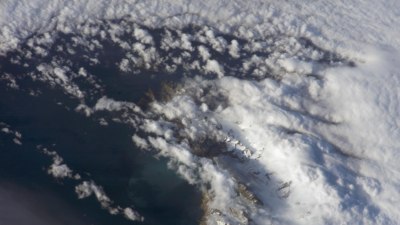How Forecast Models Handle Complex Terrain
Explore how weather forecast models adapt to complex terrain for accurate predictions in mountainous and varied landscapes.

Image created with Flux Schnell
Forecasting weather accurately in regions with complex terrain remains one of the most challenging aspects of meteorology. Mountains, valleys, ridges, and varied elevation drastically influence atmospheric patterns, creating microclimates and weather phenomena not easily captured by standard numerical weather prediction (NWP) models. Understanding how forecast models handle complex terrain involves examining their design, data assimilation methods, and special techniques adapted to rugged topographies.
Understanding Complex Terrain and Its Meteorological Impact
Complex terrain refers to geographical areas characterized by significant changes in topography, such as mountain ranges, hills, plateaus, and valleys. These features influence local weather conditions through orographic lifting, thermal gradients, wind channeling, and varying solar insolation. For example, as air masses move over mountains, they are forced to rise, leading to cooling and condensation that often results in precipitation on windward sides and drier conditions on leeward slopes.
Additionally, valleys can trap cold air and create inversions, while slopes exposed to the sun may experience enhanced heating and upslope winds during the day. These localized phenomena require models to have a high degree of spatial resolution and accurate physical parameterizations to capture the nuances of weather patterns influenced by terrain.
Numerical Weather Prediction Models and Representation of Terrain
Most forecast models rely on gridded representations of the atmosphere, where the earth's surface is divided into discrete cells. The resolution of these grids, typically ranging from kilometers to tens of kilometers, determines how well topographic features are represented. Higher resolution models better capture terrain details, but require significant computational resources.
One core challenge is representing sub-grid scale terrain features—those smaller than the model's grid spacing. To address this, models use parameterizations or statistical methods to approximate their effects on atmospheric processes. For example, sub-grid scale orographic drag schemes simulate the drag exerted by small-scale mountains on wind flow, which affects boundary layer dynamics and turbulence.
Topographic Data and Model Initialization
Accurate topographic data are essential for forecast models to correctly represent complex terrain. Digital Elevation Models (DEMs) provide high-resolution surface height data that are integrated into the models during initialization. Advances in remote sensing technologies, such as LIDAR and satellite imagery, have improved the precision of DEMs, allowing models to incorporate detailed terrain features.
Topography influences surface characteristics like soil type, vegetation, and moisture availability, which in turn affect energy exchanges between the land and atmosphere. Therefore, models not only use topographic height but also surface property datasets linked to terrain features to better simulate local meteorological conditions.
Physical Parameterizations Tailored for Complex Terrain
Physical parameterizations translate real-world processes that occur below grid scale into model equations. In complex terrain, specific adaptations are necessary. Orographic precipitation schemes, for instance, account for the process where moist air rises over mountains, cools, and forms precipitation. These schemes estimate enhanced precipitation amounts on windward slopes and rain shadows on leeward sides.
Soil-atmosphere interaction parameterizations are also adjusted to reflect varied surface conditions across slopes and valleys, impacting evapotranspiration and boundary layer evolution. Moreover, turbulence closure models consider the enhanced mechanical mixing caused by steep slopes and variable wind flow patterns.
Convection and Microphysics in Mountainous Regions
Mountainous regions experience unique convective activity, often triggered by daytime heating of slopes (anabatic winds) and thermally driven upslope flows. Forecast models incorporate convection parameterizations that adapt dynamically based on terrain-induced thermal gradients. Some high-resolution models employ explicit convection, resolving individual updrafts and downdrafts, which improves simulation in complex terrain.
Cloud microphysics schemes model processes like cloud droplet formation, ice crystal growth, and precipitation formation. In complex terrain, orographic lifting affects cloud development, necessitating microphysics that can respond to dynamic changes induced by terrain. Accurate microphysical modeling improves forecasts of precipitation type and intensity, vital in mountainous areas subject to rain, snow, or freezing rain.
Resolution and Computational Challenges
Increasing horizontal and vertical resolution enhances a model's ability to resolve terrain features. For instance, moving from a 10-kilometer grid spacing to 1-kilometer spacing offers dramatically improved terrain representation. However, finer resolution increases the computational cost exponentially, requiring powerful supercomputers.
Vertical resolution is equally important. Complex terrain often features sharp elevation changes that affect atmospheric layers differently. Models with more vertical levels near the surface can better capture phenomena like valley inversions and mountain waves. Adaptive mesh refinement techniques are sometimes employed to selectively increase resolution in areas of interest.
Data Assimilation in Rugged Terrain
Assimilating observational data is crucial for initializing models accurately. Complex terrain poses challenges for data assimilation due to sparse observational networks, radar shadowing, and heterogeneous conditions. Satellite observations can fill gaps but often require careful processing to account for terrain-induced biases.
Advanced assimilation techniques merge model forecasts with observations using sophisticated algorithms like ensemble Kalman filters and 4D-Var methods. These procedures incorporate terrain information to adjust model initial states realistically, improving forecasts in complicated topographic regions.
Mountain-Specific Phenomena Captured in Models
Models strive to replicate mountain meteorological phenomena, including downslope winds (such as Foehn or Chinook winds), valley breezes, katabatic flows, and mountain waves. Each of these greatly influences local weather and forecasts. Parameterizations and model dynamics incorporate mechanisms responsible for these effects, often validated through field campaigns and high-density observational datasets.
Mountain waves, generated by stable airflow over ridges, may cause turbulence and influence cloud formation. Incorporating gravity wave drag parameterizations models their effect on large-scale circulation. Additionally, simulating snowpack evolution on mountain slopes influences hydrological forecasting and avalanche prediction.
Model Examples Specialized for Complex Terrain
Several operational and research models are tailored to functions in complex terrain. The Weather Research and Forecasting (WRF) model, known for its flexible physics options and high resolution, is widely used for mountainous meteorology studies. The Alpine Weather Forecasting System specializes in the European Alps region, incorporating detailed topographic data and local climatology.
Other regional models incorporate nesting techniques, embedding high-resolution grids within coarser parent grids to optimize computational resources while maintaining terrain fidelity in critical areas.
Limitations and Ongoing Research
Despite advances, forecast models still face limitations in complex terrain forecasting. Unresolved sub-grid processes, insufficient observational data, and computational constraints present ongoing challenges. Research continues into improving parameterizations, assimilation methods, and machine learning techniques to enhance terrain representation.
Progress in high-performance computing facilitates increasingly fine resolutions, while interdisciplinary collaborations contribute to better understanding of terrain-related atmospheric processes. Field campaigns collecting targeted observations in complex terrain provide valuable data for model validation and improvement.
The Future of Terrain-Inclusive Forecast Models
The integration of artificial intelligence, adaptive mesh refinement, and enhanced multi-scale data assimilation promises further improvements in forecasting accuracy over complex terrain. Innovations in remote sensing and sensor deployment increase data availability in previously under-observed mountainous regions.
Additionally, coupling atmospheric models with hydrological and ecological models enables comprehensive environmental forecasts, important for managing water resources, natural hazards, and climate impacts in mountainous areas. User-driven requirements stimulate model development oriented towards local scales and practical applications.
In summary, handling complex terrain within forecast models requires detailed terrain data, specialized physical parameterizations, high resolution, and advanced data assimilation methods. While challenges remain, continuous technological and scientific advancements are closing the gaps, enabling more reliable and actionable weather forecasts in the world's most topographically diverse regions.











